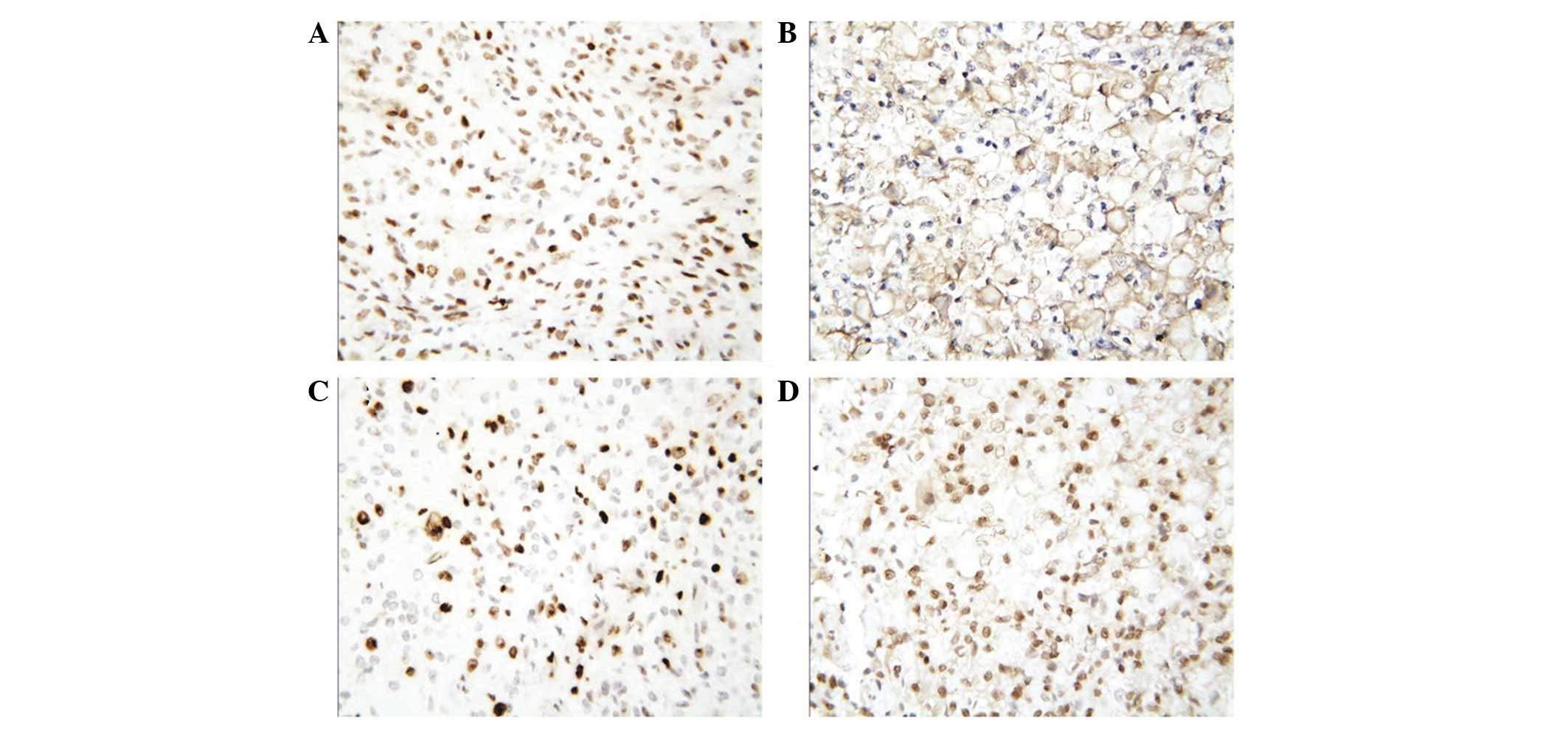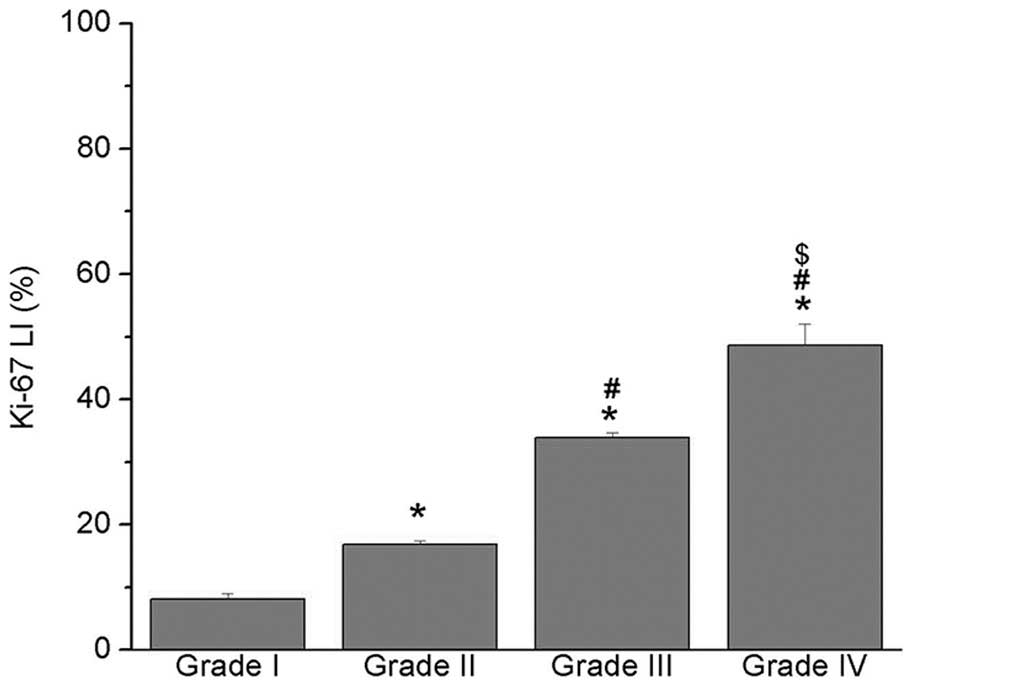|
1.
|
Kogiku M, Ohsawa I, Matsumoto K, et al:
Prognosis of glioma patients by combined immunostaining for
survivin, Ki-67 and epidermal growth factor receptor. J Clin
Neurosci. 15:1198–1203. 2008. View Article : Google Scholar : PubMed/NCBI
|
|
2.
|
van den Bent MJ and Kros JM: Predictive
and prognostic markers in neuro-oncology. J Neuropathol Exp Neurol.
66:1074–1081. 2007.PubMed/NCBI
|
|
3.
|
Noble M and Dietrich J: The complex
identity of brain tumors: emerging concerns regarding origin,
diversity and plasticity. Trends Neurosci. 27:148–154. 2004.
View Article : Google Scholar : PubMed/NCBI
|
|
4.
|
Kyritsis AP, Bondy ML, Hess KR, et al:
Prognostic significance of p53 immunoreactivity in patients with
glioma. Clin Cancer Res. 1:1617–1622. 1995.PubMed/NCBI
|
|
5.
|
Levidou G, El-Habr E, Saetta AA, et al:
P53 immunoexpression as a prognostic marker for human astrocytomas:
a meta-analysis and review of the literature. J Neurooncol.
100:363–371. 2010. View Article : Google Scholar : PubMed/NCBI
|
|
6.
|
Hoelzinger DB, Mariani L, Weis J, et al:
Gene expression profile of glioblastoma multiforme invasive
phenotype points to new therapeutic targets. Neoplasia. 7:7–16.
2005. View Article : Google Scholar : PubMed/NCBI
|
|
7.
|
Shinojima N, Tada K, Shiraishi S, et al:
Prognostic value of epidermal growth factor receptor in patients
with glioblastoma multiforme. Cancer Res. 63:6962–6970.
2003.PubMed/NCBI
|
|
8.
|
Montine TJ, Vandersteenhoven JJ, Aguzzi A,
et al: Prognostic significance of Ki-67 proliferation index in
supratentorial fibrillary astrocytic neoplasms. Neurosurgery.
34:674–679. 1994. View Article : Google Scholar : PubMed/NCBI
|
|
9.
|
von Deimling A, Korshunov A and Hartmann
C: The next generation of glioma biomarkers: MGMT methylation, BRAF
fusions and IDH1 mutations. Brain Pathol. 21:74–87. 2011.PubMed/NCBI
|
|
10.
|
Wiencke JK, Aldape K, McMillan A, et al:
Molecular features of adult glioma associated with patient
race/ethnicity, age, and a polymorphism in
O6-methylguanine-DNA-methyltransferase. Cancer Epidemiol Biomarkers
Prev. 14:1774–1783. 2005. View Article : Google Scholar : PubMed/NCBI
|
|
11.
|
Fan KJ and Pezeshkpour GH: Ethnic
distribution of primary central nervous system tumors in
Washington, DC, 1971 to 1985. J Natl Med Assoc. 84:858–863.
1992.PubMed/NCBI
|
|
12.
|
Srivastava P, Jaiswal PK, Singh V and
Mittal RD: Role of p53 gene polymorphism and bladder cancer
predisposition in northern India. Cancer Biomark. 8:21–28.
2011.PubMed/NCBI
|
|
13.
|
Pardo FS, Hsu DW, Zeheb R, Efird JT,
Okunieff PG and Malkin DM: Mutant, wild type, or overall p53
expression: freedom from clinical progression in tumours of
astrocytic lineage. Br J Cancer. 91:1678–1686. 2004.PubMed/NCBI
|
|
14.
|
Louis DN, Ohgaki H, Wiestler OD, et al:
The 2007 WHO classification of tumours of the central nervous
system. Acta Neuropathol. 114:97–109. 2007. View Article : Google Scholar : PubMed/NCBI
|
|
15.
|
Bourdon JC, Laurenzi VD, Melino G and Lane
D: p53: 25 years of research and more questions to answer. Cell
Death Differ. 10:397–399. 2003.PubMed/NCBI
|
|
16.
|
Nicholas MK, Lukas RV, Jafri NF, Faoro L
and Salgia R: Epidermal growth factor receptor - mediated signal
transduction in the development and therapy of gliomas. Clin Cancer
Res. 12:7261–7270. 2006. View Article : Google Scholar : PubMed/NCBI
|
|
17.
|
De Luca A, Carotenuto A, Rachiglio A, et
al: The role of the EGFR signaling in tumor microenvironment. J
Cell Physiol. 214:559–567. 2008.PubMed/NCBI
|
|
18.
|
Wang A, Li J and Huang Q: Preliminary
studies on the target inhibition effect of epidermal growth factor
receptor inhibitor on proliferation of glioma cells. J Int Neurol
Neurosurg. 36:189–192. 2009.(In Chinese).
|
|
19.
|
Hofer S and Lassman AB: Molecular markers
in gliomas: impact for the clinician. Target Oncol. 5:201–210.
2010. View Article : Google Scholar : PubMed/NCBI
|
|
20.
|
Ambroise MM, Khosla C, Ghosh M,
Mallikarjuna VS and Annapurneswari S: The role of
immunohistochemistry in predicting behavior of astrocytic tumors.
Asian Pac J Cancer Prev. 11:1079–1084. 2010.PubMed/NCBI
|
|
21.
|
Ohgaki H, Dessen P, Jourde B, et al:
Genetic pathways to glioblastoma: a population-based study. Cancer
Res. 64:6892–6899. 2004. View Article : Google Scholar : PubMed/NCBI
|
|
22.
|
Gerdes J, Li L, Schlueter C, et al:
Immunobiochemical and molecular biologic characterization of the
cell proliferation-associated nuclear antigen that is defined by
monoclonal antibody Ki-67. Am J Pathol. 138:867–873. 1991.
|
|
23.
|
Johannessen AL and Torp SH: The clinical
value of Ki-67/MIB-1 labeling index in human astrocytomas. Pathol
Oncol Res. 12:143–147. 2006. View Article : Google Scholar : PubMed/NCBI
|
|
24.
|
Habberstad AH, Gulati S and Torp SH:
Evaluation of the proliferation markers Ki-67/MIB-1, mitosin,
survivin, pHH3, and DNA topoisomerase IIα in human anaplastic
astrocytomas - an immunohistochemical study. Diagn Pathol.
6:432011.PubMed/NCBI
|
|
25.
|
Stupp R, Hegi ME, Mason WP, et al: Effects
of radiotherapy with concomitant and adjuvant temozolomide versus
radiotherapy alone on survival in glioblastoma in a randomised
phase III study: 5-year analysis of the EORTC-NCIC trial. Lancet
Oncol. 10:459–466. 2009.
|
|
26.
|
Nakasu S, Fukami T, Jito J and Matsuda M:
Prognostic significance of loss of O6-methylguanine-DNA
methyltransferase expression in supratentorial diffuse low-grade
astrocytoma. Surg Neurol. 68:603–609. 2007. View Article : Google Scholar : PubMed/NCBI
|
|
27.
|
Yang Z, Deng Y, Fang J, et al: Expressions
of LRP, MGMT and Topo IIα in brain glioma and normal brain tissue
and their significances. J Clin Res. 25:393–396. 2008.(In
Chinese).
|












